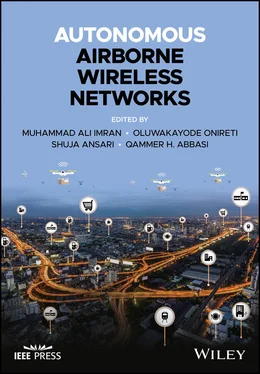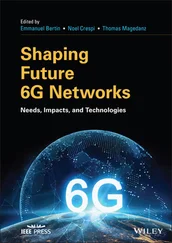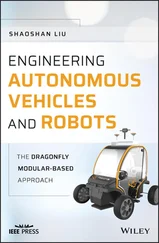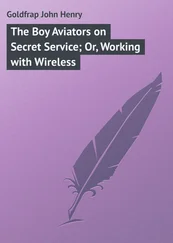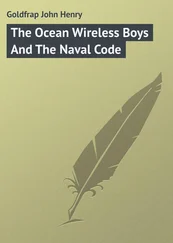5 5 Fotouhi, A., Qiang, H., Ding, M. et al. (2019). Survey on UAV cellular communications: practical aspects, standardization advancements, regulation, and security challenges. IEEE Communications Surveys Tutorials 21 (4): 3417–3442.
6 6 Molisch, A. (2011). Wireless Communications. Wiley ‐ IEEE.
7 7 3GPP (2017). Study on Enhanced LTE Support for Aerial Vehicles. Technical report, 3rd Generation Partnership Project 3GPP.
8 8 Yanmaz, E., Kuschnig, R., and Bettstetter, C. (2011). Channel measurements over 802.11a‐based UAV‐to‐ground links. 2011 IEEE GLOBECOM Workshops (GC Wkshps), pp. 1280–1284.
9 9 Yanmaz, E., Kuschnig, R., and Bettstetter, C. (2013). Achieving air‐ground communications in 802.11 networks with three‐dimensional aerial mobility. 2013 Proceedings IEEE INFOCOM, pp. 120–124.
10 10 Ahmed, N., Kanhere, S.S., and Jha, S. (2016). On the importance of link characterization for aerial wireless sensor networks. IEEE Communications Magazine 54 (5): 52–57.
11 11 Khawaja, W., Guvenc, I., and Matolak, D. (2016). UWB channel sounding and modeling for UAV air‐to‐ground propagation channels. 2016 IEEE Global Communications Conference (GLOBECOM), pp. 1–7.
12 12 Newhall, W.G., Mostafa, R., Dietrich, C. et al. (2003). Wideband air‐to‐ground radio channel measurements using an antenna array at 2 GHz for low‐altitude operations. IEEE Military Communications Conference, 2003. MILCOM 2003, Volume 2, pp. 1422–1427.
13 13 Tu, H.D. and Shimamoto, S. (2009). A proposal of wide‐band air‐to‐ground communication at airports employing 5‐GHz band. 2009 IEEE Wireless Communications and Networking Conference, pp. 1–6.
14 14 Matolak, D.W. and Sun, R. (2017). Air‐ground channel characterization for unmanned aircraft systems‐part III: the suburban and near‐urban environments. IEEE Transactions on Vehicular Technology 66 (8): 6607–6618.
15 15 Sun, R. and Matolak, D.W. (2017). Air‐ground channel characterization for unmanned aircraft systems part II: Hilly and mountainous settings. IEEE Transactions on Vehicular Technology 66 (3): 1913–1925.
16 16 Meng, Y.S. and Lee, Y.H. (2011). Measurements and characterizations of air‐to‐ground channel over sea surface at C‐band with low airborne altitudes. IEEE Transactions on Vehicular Technology 60 (4): 1943–1948.
17 17 Al‐Hourani, A., Kandeepan, S., and Lardner, S. (2014). Optimal lap altitude for maximum coverage. IEEE Wireless Communications Letters 3 (6): 569–572.
18 18 Bor‐Yaliniz, R.I., El‐Keyi, A., and Yanikomeroglu, H. (2016). Efficient 3‐D placement of an aerial base station in next generation cellular networks. 2016 IEEE International Conference on Communications (ICC), pp. 1–5.
19 19 Bor‐Yaliniz, I. and Yanikomeroglu, H. (2016). The new frontier in ran heterogeneity: multi‐tier drone‐cells. IEEE Communications Magazine 54 (11): 48–55.
20 20 Hayajneh, A.M., Zaidi, S.A.R., McLernon, D.C., and Ghogho, M. (2016). Drone empowered small cellular disaster recovery networks for resilient smart cities. 2016 IEEE International Conference on Sensing, Communication and Networking (SECON Workshops), pp. 1–6.
21 21 Gomez, K., Hourani, A., Goratti, L. et al. (2015). Capacity evaluation of aerial LTE base‐stations for public safety communications. 2015 European Conference on Networks and Communications (EuCNC), pp. 133–138.
22 22 Chen, M., Mozaffari, M., Saad, W. et al. (2017). Caching in the sky: proactive deployment of cache‐enabled unmanned aerial vehicles for optimized quality‐of‐experience. IEEE Journal on Selected Areas in Communications 35 (5): 1046–1061.
23 23 Challita, U. and Saad, W. (2017). Network formation in the sky: unmanned aerial vehicles for multi‐hop wireless backhauling. GLOBECOM 2017 ‐ 2017 IEEE Global Communications Conference, pp. 1–6.
24 24 Kalantari, E., Yanikomeroglu, H., and Yongacoglu, A. (2016). On the number and 3D placement of drone base stations in wireless cellular networks. 2016 IEEE 84th Vehicular Technology Conference (VTC‐Fall).
25 25 Shakhatreh, H., Khreishah, A., Chakareski, J. et al. (2016). On the continuous coverage problem for a swarm of UAVs. 2016 IEEE 37th Sarnoff Symposium, pp. 130–135.
26 26 Azari, M.M., Rosas, F., Chen, K., and Pollin, S. (2016). Joint sum‐rate and power gain analysis of an aerial base station. 2016 IEEE Globecom Workshops (GC Wkshps), pp. 1–6.
27 27 Hayajneh, A.M., Zaidi, S.A.R., McLernon, D.C., and Ghogho, M. (2016). Optimal dimensioning and performance analysis of drone‐based wireless communications. 2016 IEEE Globecom Workshops (GC Wkshps), pp. 1–6.
28 28 Jia, S. and Zhang, L. (2017). Modelling unmanned aerial vehicles base station in ground‐to‐air cooperative networks. IET Communications 11 (8): 1187–1194.
29 29 Mozaffari, M., Saad, W., Bennis, M., and Debbah, M. (2016). Efficient deployment of multiple unmanned aerial vehicles for optimal wireless coverage. IEEE Communications Letters 20 (8): 1647–1650.
30 30 Mozaffari, M., Saad, W., Bennis, M., and Debbah, M. (2015). Drone small cells in the clouds: design, deployment and performance analysis. In 2015 IEEE Global Communications Conference (GLOBECOM), pp. 1–6.
31 31 Mozaffari, M., Saad, W., Bennis, M., and Debbah, M. (2017). Mobile unmanned aerial vehicles (UAVs) for energy‐efficient internet of things communications. IEEE Transactions on Wireless Communications 16 (11): 7574–7589.
32 32 Azari, M.M., Rosas, F., Chen, K., and Pollin, S. (2018). Ultra reliable UAV communication using altitude and cooperation diversity. IEEE Transactions on Communications 66 (1): 330–344.
33 33 Alzenad, M., El‐Keyi, A., Lagum, F., and Yanikomeroglu, H. (2017). 3‐D placement of an unmanned aerial vehicle base station (UAV‐BS) for energy‐efficient maximal coverage. IEEE Wireless Communications Letters 6 (4): 434–437.
34 34 Alzenad, M., El‐Keyi, A., and Yanikomeroglu, H. (2018). 3‐D placement of an unmanned aerial vehicle base station for maximum coverage of users with different QoS requirements. IEEE Wireless Communications Letters 7 (1): 38–41.
35 35 Khuwaja, A.A., Zheng, G., Chen, Y., and Feng, W. (2019). Optimum deployment of multiple UAVs for coverage area maximization in the presence of co‐channel interference. IEEE Access 7: 85203–85212.
36 36 International Telecommunication Union (ITU) (2003). Propagation Data and Prediction Methods for the Design of Terrestrial Broadband Millimetric Radio Access Systems. Technical report. International Telecommunication Union (ITU).
37 37 3GPP (2018). Study on Channel Model for Frequencies from 0.5 to 100 GHz. Technical report. 3rd Generation Partnership Project (3GPP).
38 38 Wentz, M. and Stojanovic, M. (2015). A MIMO radio channel model for low‐altitude air‐to‐ground communication systems. 2015 IEEE 82nd Vehicular Technology Conference (VTC2015‐Fall), pp. 1–6.
39 39 Gulfam, S.M., Nawaz, S.J., Ahmed, A., and Patwary, M.N. (2016). Analysis on multipath shape factors of air‐to‐ground radio communication channels. 2016 Wireless Telecommunications Symposium (WTS), pp. 1–5.
40 40 Zeng, L., Cheng, X., Wang, C., and Yin, X. (2017). Second order statistics of non‐isotropic UAV ricean fading channels. 2017 IEEE 86th Vehicular Technology Conference (VTC‐Fall), pp. 1–5.
41 41 Blandino, S., Kaltenberger, F., and Feilen, M. (2015). Wireless channel simulator testbed for airborne receivers. 2015 IEEE Globecom Workshops (GC Wkshps), pp. 1–6.
42 42 Ksendzov, A. (2016). A geometrical 3D multi‐cluster mobile‐to‐mobile MIMO channel model with rician correlated fading. 2016 8th International Congress on Ultra Modern Telecommunications and Control Systems and Workshops (ICUMT), pp. 191–195.
43 43 Gao, X., Chen, Z., and Hu, Y. (2013). Analysis of unmanned aerial vehicle MIMO channel capacity based on aircraft attitude. WSEAS Transactions on Information Science and Applications 10 (2): 58–67.
Читать дальше
